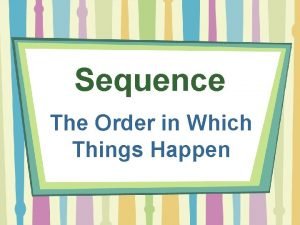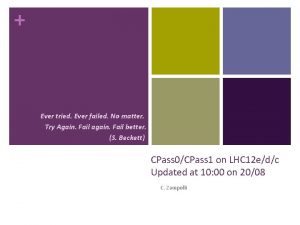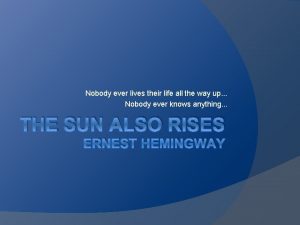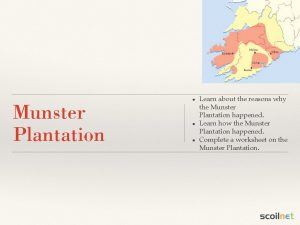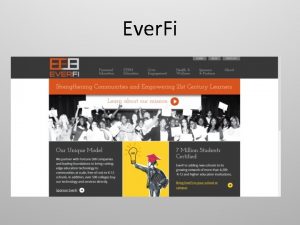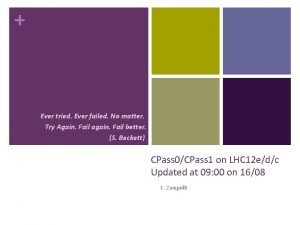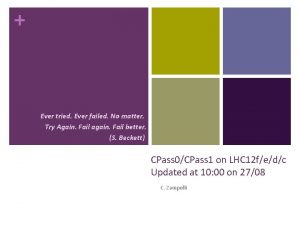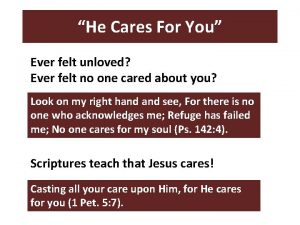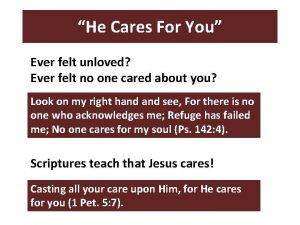Joint Programming will it ever happen Joint Programming























- Slides: 23

Joint Programming… … will it ever happen…?

Joint Programming - History Pilots Results so far Studies Policy imperatives Way ahead

History of Joint Programming (1) • • • - Council Resolution on Harmonisation & Coordination, 1974. - Council Resolutions on Coordination, 1976, 1984, and 1986. - “Horizon 2000”, 1992: harmonise and coordinate. - Council Resolution on Complementarity, 1995. - Guidelines agreed on coordination, 1998. - Council conclusions on Coordination, 2000. - Barcelona Commitments, 2004: recommends common sector policies. EU initiatives on aid effectiveness should always be open for other donors to join. - Ad Hoc Working Party on Harmonisation Report, 2004: recommends a joint EU approach for programming aid, common implementation procedures, and more decentralised decision-making. - EU Consensus on Development, 2005: sets out a common aim and principles for the EC’s and EU MS’ development work. - Delivering More, Better, Faster, 2006: emphasises the need to review rules and procedures - Joint Framework for Country Strategy Papers, 2006: sets out a path towards joint programming by the EC and EU MS, also including other donors where possible. .

History of Joint Programming (2) • - EU Code of Conduct on Division of Labour, 2007: proposes limiting country involvement to three active sectors per donor and five donors per sector. • - Fast Track Initiative, 2008: speed up the implementation of the Code of Conduct in 30 countries. • - Operational Framework on Aid Effectiveness, 2009/2011 • - Council Conclusions on the MDGs for the UN High Level Plenary Meeting, 2010: confirmation of earlier commitments to reduce aid fragmentation. • - Letter from EU DGs to all Ambassadors and Heads of Cooperation, 2010: reaffirms commitment to Do. L and emphasises the need for results as opposed to only process and analysis. Reaffirms commitment to joint programming. • - Number of Technical Seminars with Member States • - Pilots, Studies • - “Agenda for Change”, Communication 2011, and Joint Programming announced in Busan, 2011. • - Letter from 3 Commissioners to Heads of Delegations, same from HQs of Member States to Embassies/representations. • - Next Opportunity: programming MFF 2014 -2020.

…. sometimes one feels like the Baron von Münchhausen …. .

Donors participating in the joint programming exercise Vs. the top 10 donors, Desk Study by i. QSG. Country N° of participating donors vs the Top 10 Donors Top 10 donors not participating and their ranking in the Top 10 list Ghana 10/10 - DRC 9/10 Global Fund (10 th) Tanzania 9/10 Global Fund (6 th) Zambia 9/10 Global Fund (6 th) Uganda 9/10 USA (1 st) Kenya 9/10 IMF (8 th) Mali 7/10 USA (6 th), Af. DB (7 th), Arab agencies (8 th) Burkina Faso 7/10 WB (2 nd), Arab agencies (8 th), Af. DB (5 th), South Africa 7/10 USA (1 th), Global Fund (6 th), GEF (10 th) Somalia 5/10 USA (1 st), Canada (6 th), Netherlands (8 th), Japan (9 th), Global Fund (10 th) Ethiopia 4/10 USA (1 st), WB (2 nd), Global Fund (5 th), Af. DB (6 th), Canada (7 th), GAVI (9 th) Dominican Republic 3/10 USA (1 st), Global Fund(4 th), Japan (5 th), Korea (8 th), Canada (9 th), Italy (10 th) Haiti 3/10 USA (1 st), Canada (2 nd), IDB Sp. Fund (3 rd), WB (6 th), IMF (7 th), Global Fund (9 th), Italy (10 th) Sierra Leone 2/10 WB (1 st), Italy (4 th), Japan (5 th), Germany (6 th), Netherlands (7 th), France(8 th), USA(9 th), Ireland (10 th)

10 th EDF Programming results – joint programming with member states Out of 14 pilot countries: • In 8 countries the CFCSPs has been taken on board: - Mali and Burkina Faso, South Africa, Sierra Leone, Ethiopia, Dominican Republic, Somalia and Haiti • In 6 countries the joint programming exercise has been carried out in the context of on-going donor-wide harmonisation processes, JAS and CAF: - Ghana, Tanzania, Uganda, Zambia, Uganda, DRC • Concrete results remain below the ambition set in the Council Conclusions. Why? Bottlenecks (i. e. lack of sufficient communication between HQs and field staff; initially high transaction costs; heterogeneous nature of donors’ programming mechanisms, such as timing, format, approval procedure, etc. • So was the joint programming exercise a missed opportunity? No! Innovative and demanding; progressive and dynamic; interest of EU and MS in going ahead. New opportunities offered by EU Code of Conduct on division of labour and MTR.

Joint Programming at the MTR of the 10 th EDF 5 JP 4 % 4 - Do. L improvement 19% 3 - Donor mapping 38% 2 - Donor coordination mechanisms 60% 1 - Adoption of strategies/Implementation Plans to integrate Paris/Accra principles 68%

Study on Synchronisation of Programming Cycles at partner country level

EU Code of Conduct on Complementarity and Division of Labour in Development Policy - Council Conclusions, May 2007 - Concentrate on limited number of sectors: 3 sectors + GBS + NSA + research & education schemes Local “sector” definition compatible with DAC and at an adequate level of detail - Redeploy for other in-country activities (through delegated cooperation modalities) - Lead donor arrangements (in charge of donor coordination) - Delegated cooperation / partnership arrangements - Ensure adequate support to key priority sectors - Replicate these practices at regional level - Identify priority countries - Address the “orphans” gap - Analyse and expand global areas of strength (comparative advantages) - Progress on other dimensions of complementarity (vertical and cross-cutting instruments) - Deepen the reform of the aid systems (further devolution to the field) • Constraints: avoid negative impact on ODA, predictability, orphan countries and sectors

Common Framework for Country Strategy Papers Includes method of coordination between donors Template with the following chapters: • Donor objectives • Country diagnosis • Political, Economic, Social, International, Environment • Poverty reduction analysis • Partner’s development strategy • Past and present cooperation • • • EC Other donors - donor matrix Political dialogue Harmonisation and alignment Policy coherence • Response strategy • Work programme (NIP/MIP)

… sometimes one feels like Don Quichotte …. .

Why Joint Programming…? • • • - Reduced fragmentation of EU assistance - Augmented impact of EU assistance - Enhanced EU coherence and visibility - Implementing the Paris and Accra commitments can lead to a total of savings and gains of € 5 billion per year…! For EU and MS combined. - Other……. ? ?

From the Council Conclusions (2006) on EU Joint Programming: which commitments? • - “Joint multi-annual programming will be aligned with country led strategies… and budget cycles”, “member states should… ensure flexibility in their own procedures to meet the alignment principle” • - “A two-step approach…: Joint analysis and joint response strategy” • - “Process should be flexible, gradual and open” • - “Joint multi-annual programming should progressively apply to all European official development assistance” • - “Joint m. -a. programming will pave the way for coordination. . . and decisions on complementarity (Do. L)” • - “Initiate a Joint response strategy in countries selected on the basis of criteria…” • - “…Common Format for CSPs as pragmatic tool” • - “… discuss concrete steps towards the development of operational principles on how to better organise the division of labour … at country level…”

Why a Commission Policy Proposal? • - Common Framework for drafting Country Strategy Papers (2006) • - The EU Code of Conduct (2007) • - Operational Framework on Aid Effectiveness (2010) • - Council Conclusions on the Millennium Development Goals (2010): Commission to present "a proposal to the Council by 2011 for progressive synchronization of EU and national programming cycles at partner country level and based on partner countries’ development strategies and taking into account their programming cycles. This process should speed up progress to develop joint EU country strategy papers and multiannual programs where appropriate. "

Why Joint Programming now? • • - Lessons learnt in pilot countries and countries of the Fast Track Initiative - Preparations for the new Multiannual Financial Framework and External Instruments post 2013 - Ongoing review of the EU’s development policy following the “Agenda for Change” - Aid Effectiveness commitments of Paris and Accra confirmed in Busan

A new definition of Joint Programming needed? • - JP is a process, jointly conducted by EU and Member States, resulting in a Joint EU Country Strategy Paper, replacing individual strategies. • - It should be: • A response to a partner country’s own development plans; • Synchronised to the programming cycles of these; • Preceded by a joint analysis of a partner country’s policies and strategies; • Inclusion of priority sectors of intervention; • Inclusion of in-country Division of Labour (with MS) • Inclusion of indicative financial allocations per sector and donor.

How to synchronise programming? • - New EU external instruments allow to synchronise with partner countries • - As from 2014, programme CPA at the beginning of a partner country’s development planning cycle • - Programme a period that coincides with the validity period of the partner country’s development plan • - Intermediary programming might need to take place • - EU and MS program together, second option for MS could be to join the others whenever programming commences for a partner country (could be any year of the first 5 or 6 years) after 2013

Modelling of progressive synchronisation of EU Joint Programming with partner countries' cycles Partner Country A National Strategy 2007 2008 2009 2010 Com CSP Member State 1 Member State 3 Member State 4 2013 2014 2019 2020 2021 2022 1 st Joint EU Country Strategy Paper, synchronised with the partner country's national strategy cycle 2018 Phase 4 2017 2016 2015 Phase 3 Member State 5 Member State 6 2012 Phase 2 Com MFF Member State 2 2011

Modelling of progressive synchronisation of EU Joint Programming with partner countries' cycles Partner Country B 2007 2008 National Strategy 2009 2010 Com CSP Member State 1 Member State 5 Member State 6 Member State 7 Member State 10 Member State 11 Member State 9 Member State 12 2015 2016 2017 2018 2019 Member State 4 2014 Member State 3 2013 Member State 8 2012 Com MFF Member State 2 2011 1 st Joint EU Country Strategy Paper, synchronised with the partner country's national strategy cycle 2020 2021 2022 2 nd Joint EU Country Strategy Paper, synchronised with the partner country's national strategy cycle

Suggestions on the Process of Joint Programming • - Which donors: EU, MS, non-EU donors; • - Which countries: in principle all partner countries, but start in a limited number, possibly those that were part of the FTI on Do. L; • - Reforms needed for: alignment, synchronisation, approval of Strategy Papers, flexible programming periods, flexible adoption procedures, flexibility in timings of reviews, etc; • - MS to change their programming in the same way!

In Conclusion…. .

Thank you…! • Cornelius. hacking@ec. europa. eu
 Order in which things happen
Order in which things happen Ever tried ever failed no matter
Ever tried ever failed no matter Ever ancient ever new
Ever ancient ever new Ever ancient ever new
Ever ancient ever new Ever ancient ever new
Ever ancient ever new Appretaite
Appretaite Break joint vs spool joint
Break joint vs spool joint Break joint vs spool joint
Break joint vs spool joint Membrana tectoria
Membrana tectoria Depression movement
Depression movement Semi permanent joints
Semi permanent joints Greedy vs dynamic
Greedy vs dynamic What is system program
What is system program Perbedaan linear programming dan integer programming
Perbedaan linear programming dan integer programming Linear vs integer programming
Linear vs integer programming Perbedaan linear programming dan integer programming
Perbedaan linear programming dan integer programming Why convection cannot happen in solids
Why convection cannot happen in solids Poetry makes nothing happen analysis
Poetry makes nothing happen analysis When did this happen
When did this happen Why did this happen
Why did this happen Munster plantation
Munster plantation Communication is inescapable
Communication is inescapable What should happen if a nobleman dies during surgery
What should happen if a nobleman dies during surgery Explain why did it happen
Explain why did it happen
